Introduction
If you want to listen to your digital music collection in your bedroom or in your living room, you don’t want to have to fire up a PC. You don’t want to hear the whirring of computer cooling fans. And you don’t want to spend thousands of dollars on a custom solution. Enter Squeezebox v3 from Slim Devices.
Squeezebox is a small, well-designed appliance that lets you listen to your digital music from any room in your home. It provides ready access and high-quality sound without requiring a media-PC. And, at $299 (as tested), it costs a lot less than a media-PC.
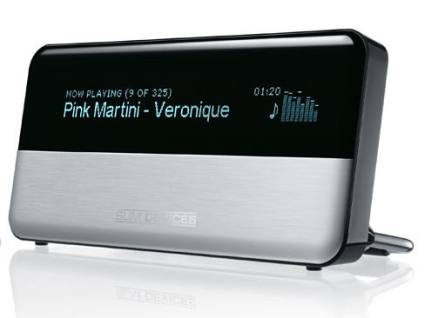
Squeezebox is small (3.5″ tall by 7.5″ wide) and silent, functioning as a music access point on your network. Using a remote and the gorgeous vacuum fluorescent display to navigate, the Squeezebox can be set up quickly. With its brush metal aluminum and black face, it can go virtually anywhere in your home, being unobtrusive and beautiful, letting you hear your music or digital audio where you want to hear it.
The Squeezebox has a solid set of audio options, with digital optical, coax, and analog connectors that can be plugged into any home theater, stereo or set of amplified speakers.
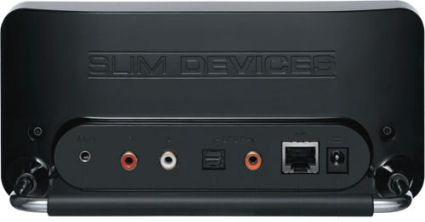
Designed by audiophiles it has a 24 bit Burr-Brown DAC that provides clean output and low distortion. It supports a number of media formats, including lossless audio for discerning listeners. It support MP3, WMA, FLAC, AAC, WAV, and Ogg Vorbis, streaming audio and can be upgraded as new formats emerge.
Squeezebox can be hooked up through either a wireless connection using 802.11g or to a wired network using a built-in Ethernet port. Slim Devices provides software clients to its SlimServer software for Windows, Mac, and Linux. The SlimServer software is released under Open Source GPL license, you’ll never have to worry about being locked out of your music, since the source code to the server software is freely available for anyone to modify.
With so much going for it, I decided to put the Squeezebox through its paces. I had reviewed the original Squeezebox for Tom’s back about a year ago, and decided to see what was new, what has improved, and what might still need work.
What You Get
To get your hands on a Squeezebox you have to buy it direct from Slim Devices. They are the only ones selling it, but they have a 30-day satisfaction guarantee, so it’s a safe purchase. You can also find the Squeezebox on Amazon, but this option essentially overlays your purchase, which is from none other than Slim Devices. For those outside the U.S., Slim Device’s website lists information on world-wide shipping.
Inside the box, the package provides the Squeezebox network music player itself; an AC Power adaptor (appropriate plug by region), the adaptor is really-really tiny, smaller than a GameBoy or PSP AC charger; a User’s manual; a 10 foot Ethernet cable (only with those models that support wired connections); Slim Device’s custom infrared remote (with 2 AAA batteries included); and a 6-foot gold plated RCA patch cord.
Following the user manual I download the SlimServer software (6.2 as of this writing). The software requires a download from the Slim Devices site, but since the site does not require any personal information I just selected the platform and downloaded.
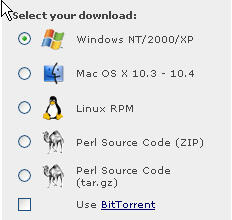
Under Windows, the setup was straightforward, with the default installation configured to automatically start the SlimServer software whenever Windows starts.
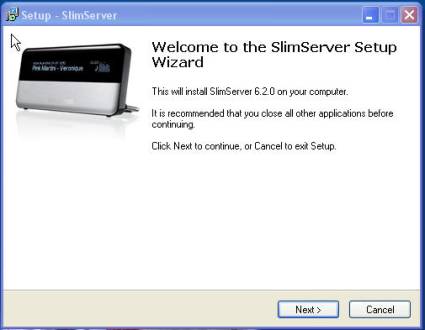
Finishing The Install
The installation placed an icon on my desktop and one in my taskbar tray and offers to open a “Getting Started” document. The document contains a mishmash of information that will most likely confuse a newbie. Clicking either of the icons starts the SlimServer and brings up the interface to the Squeezebox.
![]()
![]()
Plugging in the Squeezebox brings up the cool blue lettering on well Squeezebox’s (320×32 pixel) screen. To get things moving along, I decided to start with hooking the Squeezebox up to the network. Using the remote’s arrow keys to navigate I selected wired from the setup option of wireless or wired setup.

I plugged the Squeezebox into a nearby Ethernet jack and told the Squeezebox to attempt to get a DHCP assigned address, which would automatically assign an Ethernet address to the appliance. This would be the simplest method, which would allow the Squeezebox, after receiving an address, to directly communicate with the SlimServer.

However, since, I didn’t have DHCP turned on at my router, I used the arrow keys and the keypad on the remote to manually assign an Ethernet address to the Squeezebox.


As soon as I had keyed in the IP address using the remote control’s keypad, the Squeezebox immediately found the SlimServer, which was installed on a Windows XP box called “WestNewbury,” making contact on the first try.

Where Is My Music?
The Squeezebox was working and it was communicating with the SlimServer, but I was greeted with a “Now Playing: Nothing” message across the beautiful display. From past experience with an earlier version of SlimServer, I remember that this is not uncommon and that I must first turn my attention from the appliance to the browser-based SlimServer before I would be able to hear my music.
I first needed to get the SlimServer to find the location of my music. The first clue to this problem was when I brought up the SlimServer’s web-browser interface and looked at the home page: my music library contains “0” albums, artists, and songs.
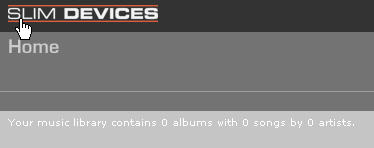
I would need to tell SlimServer where my music files are located. Opening the Server Settings, I added a path to the directory where I keep my music.
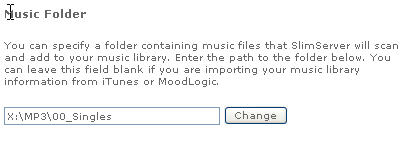
Sounding a bit like Brittany Spears, Slim still didn’t like my music folder:

Still Looking For The Music…
I decided to try something local – a local folder on the same drive as the SlimServer – instead of pointing the SlimServer to a music folder located on a network-attached drive, I created a folder on the same server I was running the SlimServer software on. I remember that I had previously gotten the remote drive to be read in an earlier incarnation of SlimServer, but rather than fight with it, this time I was content to bend to its will, since the SlimServer liked the local folder.

I then told the SlimServer to “rescan” my music library, which adds the tracks to its database. After what I considered a very lengthy rescan period – more than a minute to build a list of 25 songs(!) – oops, nope, nothing yet in the play list. Now I go back to the SlimServer “Home” and decide to select “browse music folder”, and viola! – all of my songs are there in all their MP3 glory!
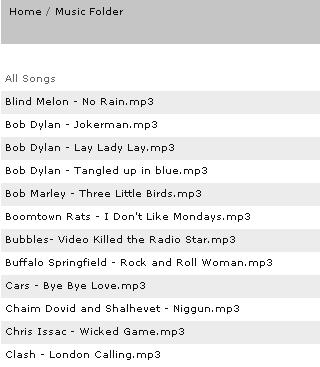
Clicking on the “Add to Playlist” icon next to the “All Songs” heading migrates the songs over to a Squeezebox playlist that makes the tracks available to the Squeezebox.
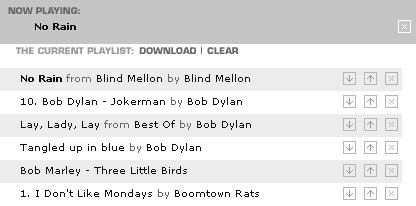
Using the remote, I can raise and lower the volume, pause, fast forward, shuffle the tunes and repeat favorites. The trick to remember is to have a playlist in the directory with your music or else you will need to manually migrate the songs you plan to listen to into a playlist before the Squeezebox appliance will recognize the presence of songs.
Finally Being Able To Listen!
To get things started, I plugged in a pair of Klipsh powered speakers that I use with my computer. The sound was as good as it gets. I then hooked up the Squeezebox to the auxiliary input of my JVC receiver, which drives a series of Paradigm speakers. The sound was fantastic and room filling. The Squeezebox did an excellent job of shuttling the audio from the network to the receiver, playing the music with no delay or distortion. Using the IR remote to communicate with the Squeezebox, informal testing showed that even 30 feet the remote still commanded with ease.
Playing ripped tracks over your stereo may seem like a one-trick pony, but the Squeezebox is anything but. Using the SlimServer browser I was able to select streaming music from across the Internet. I picked something from World Music. The SlimServer showed that I was playing Celtic music live from Ireland, while the Squeezebox showed not the name of the song, but the name of the show. In this case, the LiveIreland show is a ShoutCast station that is streamed free over the Internet and at 128 kbps it sounded fantastic.
So What Is New With Version 3?
If you already have a Squeezebox, you may be wondering what’s different between the first-generation Squeezebox, Squeezebox2 and now the third-generation Squeezebox? The first thing you notice is that the third-generation Squeezebox has a completely redesigned form factor, though it is functionally identical to Squeezebox2. Features that distinguish the latest generation from the first-generation Squeezebox include:
- An upgrade to 802.11g networking, with support for current encryption standards and throughput up to 54 Mbps
- An upgraded vacuum fluorescent display with more than twice the resolution (320×32 pixels).
- A 30 frame-per-second stereo spectrum analyzer on the Squeezebox display. The animations allow you to see balance and the spectrum analysis can display as a small set of icons or as an overlay that lights up the length of the entire display.
- Wireless bridging – plug other wired Ethernet devices in to the wireless Squeezebox, and they’re on the network
- Native WMA support; provides playback capability not only for WMA files, but also many internet radio stations
- High fidelity 24 bit Burr-BrownTM DAC
- High precision dedicated crystal clocks and separate linear power supplies for the audio stages. The S/PDIF interface and DAC clocks are driven directly by two dedicated crystal oscillator circuits running at fixed frequencies. Other devices generally typically use a PLL circuit or resampling techniques to simulate multiple clock frequencies, which may introduce noise from the power supply and other environmental factors. By using dedicated fixed oscillators, Squeezebox eliminates the predominant source of reampling noise, jitter, and clock imprecision in S/PDIF sources.
- A 64 megabit buffer for resilience to adverse wireless network conditions.
- Improved upgradeability – all audio format decoding, synthesis, filtering, mixing, and attenuation operations are tuneable and upgradeable with firmware. Even all of the audio-releated logic circuitry, such as the encoding of the S/PDIF output signal and the presentation of data to the DAC, are implemented in a field-upgradeable Xilinx gate array.
- SqueezeNetwork – allows access to your favorite internet radio stations, alarms, and more without a computer being on
- Cross fading between songs
- 100Mbps wired Ethernet interface
Some of these updates are enough that with a discerning pair of ears (and speakers) the Squeezebox v3 really outshines its earlier incarnations.
The SlimServer software, on the other hand, still needs work. Version 6.2 looks (and acts) a lot like its earlier incarnations. While sections have been added for Internet radio, the standard audiophile will still not find it intuitive to get their music collection to actually show up for playing by the Squeezebox. Many may be left puzzling over the disconnect between having your audio files showing up on the SlimServer page and getting those same files to migrate over to a playlist that the Squeezebox can play.
The remote itself has not changed noticeably since the original. If anything, the original remote is better at resisting fingerprints, and the light blue “play” buttons of the earlier version made it easier to find this critical function.
Conclusion

There is no doubt that the SqueezeBox is a capable music access point, which transforms your audio files into high fidelity audio. It also has a whole slew of additional gewgaws and capabilities that I haven’t covered in this review, such as how Squeezebox is compatible with 40/64 bit WEP encryption, 128 bit WEP encryption, and WPA Personal encryption. Or how Squeezebox integrates with iTunes (yes, SlimServer can uncompress unprotected – non-DRMed – AAC files and send the raw audio to the Squeezebox on-the-fly). It is scary how much thought has been put into making the Squeezebox a useful audio tool.
Squeezebox Pros
- Excellent, easy-to-read display (even better than before)
- Lots of connectivity options
- Fantastic cross-platform support
- Outstanding support for a broad array of digital audio formats
Squeezebox Cons
- Adding music to the master playlist could (still) be more intuitive
